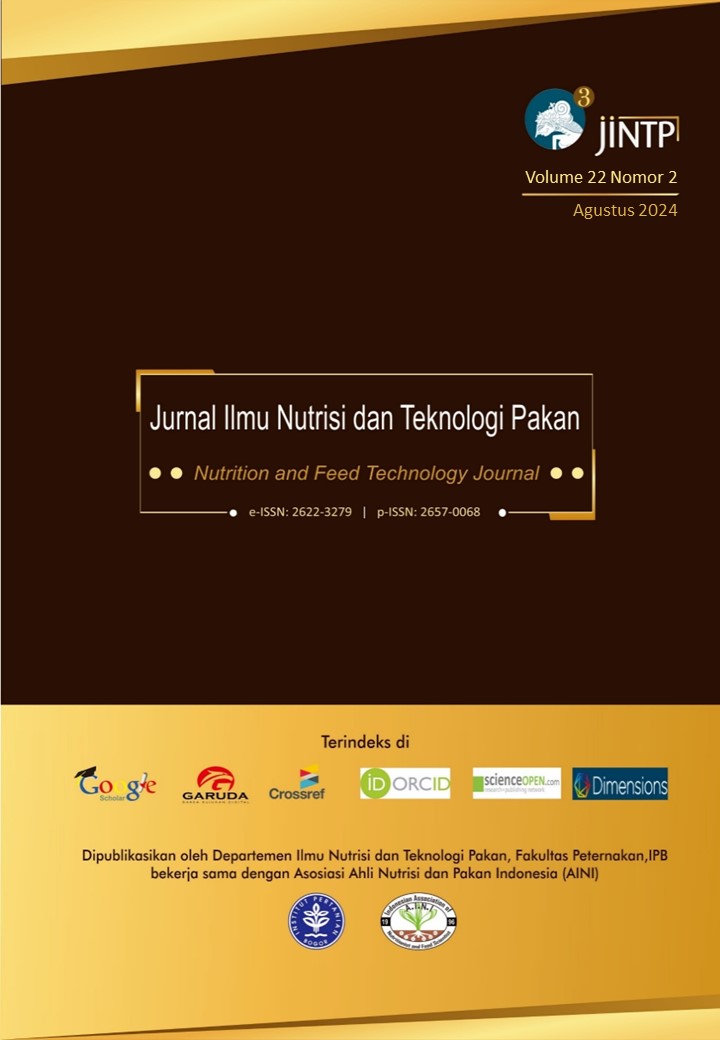Daya Cerna dan Karakteristik Fermentasi Rumen dengan Penambahan Asam Amino Terenkapsulasi secara In Vitro
In Vitro Digestibility and Rumen Fermentation Characteristics with the Addition of Encapsulated Amino Acid
Abstract
Amino acid protection is one of the efforts to improve livestock feed quality. Lysine is one of the limiting amino acids, which is easily degraded in the rumen, and thus requires a protection. This study aimed to determine the effect of protected lysine on cattle's digestive system and ruminal ecology in vitro. This study used encapsulation using xanthan gum and tannin (2% w/v) to protect lysine. The treatments consisted of P0 = unprotected amino acids; P1 = amino acids + 2 g xanthan gum; P2 = amino acids + 2 g tannin; P3 = amino acids + 2 g xanthan gum + 2 g tannin. Parameters observed included nutrient content, chemical activity, degradability of organic matter (OM) and crude protein (CP), and rumen fermentability (pH, N-NH3, VFA, gas kinetics, and CH4). A combination of xanthan gum and tannin coatings (P3) resulted in a higher effect (p<0.05) on rumen fermentation compared to others. The Undegraded DM and CP values in the rumen were 48% and 32%, respectively, and in the pepsin-HCl were 15% and 89%. All treatments did not change the rumen fermentability. In conclusion, protected amino acids has a effect on the cattle digestion system without disturbing the rumen ecology. Combining xanthan gum and tannin coatings provides the best results than using a single type of coating.
Key words: amino acids, encapsulation, rumen fermentation, tannin, xanthan gum
Downloads
References
Abbasi I H R, Abbasi F, El-Hack M E A, Swelum A A, Yao J & Cao Y. 2018. Postruminal effects of rumen-protected methionine supplementation with low protein diet using long-term simulation and in vitro digestibility technique. AMB Express. 8(1): 4-8.
AOAC. 2005. Official Method of Analysis (AOAC International, Arlington, 2005)
Cahyani R D, Nuswantara L K & Subrata A. 2012. Pengaruh proteksi protein tepung kedelai dengan tanin daun bakau terhadap konsentrasi amonia, undegraded protein dan protein total secara In Vitro. Animal Agricultural Journal. 1(1): 159 –166.
De Meutter R & Goormaghtigh E. 2021. Evaluation of protein secondary structure from FTIR specta improved afte partial deuteration. European Biophysics Journal. 50:613–628.
Fidriyanto R, Juanssilfero AB, Sarwono KA, Ridwan R, Nahrowi N, & Jayanegara A. 2024. Enhancing physicochemical, rheological properties, and in vitro rumen fermentation of starch with Melastoma candidum D. Don fruit extract. Animal Science Journal. 95 (1):e13950.
Gustiani S, Helmy Q, Kasipah & Novarini E. 2018. Produksi dan karakterisasi gum xanthan dari ampas tahu sebagai pengental pada proses tektil. Arena Tekstil 32(2): 51-58.
Hidayah N. 2016. Pemanfaatan senyawa metabolit sekunder tanaman (tanin dan saponin) dalam mengurangi emisi metan ternak ruminansia. Jurnal Sains Peternakan Indonesia. 11(2) :89-98.
Imran M, Pasha TN, Shahid MQ, Babar I & Haque Naveed MNU. 2017. Effect of increasing dietary metabolizable protein on nitrogen efficiency in Holstein dairy cows. Asian-Australasian Journal of Animal Science. 30(5):660–665.
Irawan A, Sofyan A, Wahyono T, Harahap MA, Febrisiantosa A, Sakti AA, Herdian H & Jayanegara A. 2023. Relationships between dietary rumen-protected lysine and methionine with the lactational performance of dairy cows—A meta-analysis. Animal Bioscience, 36(11): 1666.
Lestari DA, Abdullah L & Despal. 2015. Comparative study of milk production and feed efficiency based on farmer best practices and National Research Council. Media Peternakan. 38(2): 110- 117.
Luber Y A, Afdal M, Adriani A, & Darsil D. 2022. Kecernaan in-sacco bahan kering, bahan organik, dan serat kasar daun bangun bangun (Coleus amboinicus L) yang diproteksi kapsul, saponin dan tanin. Jurnal Wahana Perternakan. 6. (1): 38-42.
Mazinani M, Naseria AA, Rude B, Valizadeh R & Tahmasbi A. 2019. Production of rumen-protected essential amino acids with chemical technique. Biosciences Biotechnology Research Asia. 16(4):789-795
Mirahsanti NPN, Suarjana IGK, & Besung INK. 2022. Angka lempeng total bakteri dan pH pada cairan rumen sapi bali jantan yang dipotong di rumah pemotongan hewan pesanggaran. Buletin Veteriner Udayana 4(5); 446-451.
Orskov ER & McDonald I. 1979. The estimation of protein degradability in the rumen from incubation measurements weighted according to rate of passage. The Journal of Agricultural Science. 92(2): 499–503.
Sarwono KA, Rohmatussolihat R, Watman M, Ratnakomala S, Astuti WD, Fidriyanto R, Ridwan R, & Widyastuti Y. 2022. Characteristics of fresh rice straw silage quality prepared with addition of lactic acid bacteria and crude cellulase. AIMS Agriculture and Food. 7(3): 481–499.
Souza, NKP, Detmann, E, Valadares Filho, SC, Costa VAC, Pina DS, Gomes DI, Queiroz AC, & Mantovani HC. 2013. Accuracy of the estimates of ammonia concentration in rumen fluid using different analytical methods. Arquivo Brasileiro de Medicina Veterinaria e Zootecnia. 65(6): 1752–1758.
Theodorou MK, Williams BA, Dhanoa MS, McAllan AB, & France J.1994. A simple gas production method using a pressure transducer to determine the fermentation kinetics of ruminant feeds. Animal Feed Science and Technology. 48(3–4): 185–197.
Tilley, JMA & Terry R A. 1963. A two-stage technique for the in vitro digestion of forage crops. Grass and Forage Science. 18(2): 104–111.
Waldi L, Suryapratama W, & Suhartati FM. 2017. Pengaruh penggunaan bungkil kedelai dan bungkil kelapa dalam ransum berbasis indeks sinkronisasi energi dan protein terhadap sintesis protein mikroba rumen sapi perah. Journal of Livestock Science and Production. 1(1): 1-12.
Zahera R, Permana IG & Despal. 2015. Utilization of mungbean’s greenhouse fodder and silage in the ration for lactating dairy cows. Media Peternakan. 38(2):123–131.
Zahera R, Anggaraeni D, Rahman ZA & Evvyernie. 2020. Pengaruh kandungan protein ransum yang berbeda terhadap kecernaan dan fermentabilitas rumen sapi perah secara in vitro. Jurnal Ilmu Nutrisi dan Teknologi Pakan. 18(1): 1-6.
Zhao L, Pan F, Mehmood A, Zhang Y, Hao S, Rehman AU, Li J, & Wang Y. 2020. Protecive effect and mechinsm of action of xanthan gum on the color stability of black rice anthocyanins in model beverage systems. International Journal of Biological Macromolecules. 18 (2000): 3800-3807.
Copyright (c) 2024 C Talapessy, M Rahayuningsih, R Fidriyanto, A Fitri, R Ridwan

This work is licensed under a Creative Commons Attribution 4.0 International License.
The authors of the submitted manuscript have to understand and agree that the copyrights published are held by Jurnal Ilmu Nutrisi dan Teknologi Pakan. Copyrights includes rights in reproducing, distributing and selling every section of articles in all forms and media. The copyright transfer form is signed by the corresponding author. The author”
• Creative Commons Attribution (CC BY)
you are allowed to:
Share – copy and redistribute the material in any medium or format
Adapt – remix, transform, and build upon the material
for any purpose, even commercially.
The licensor cannot revoke these freedoms as long as you follow the license terms.
Jurnal Ilmu Nutrisi dan Teknologi Pakan (Nutrition and Feed Technology Journal)

This work is licensed under a Creative Commons Attribution 4.0 International License.












